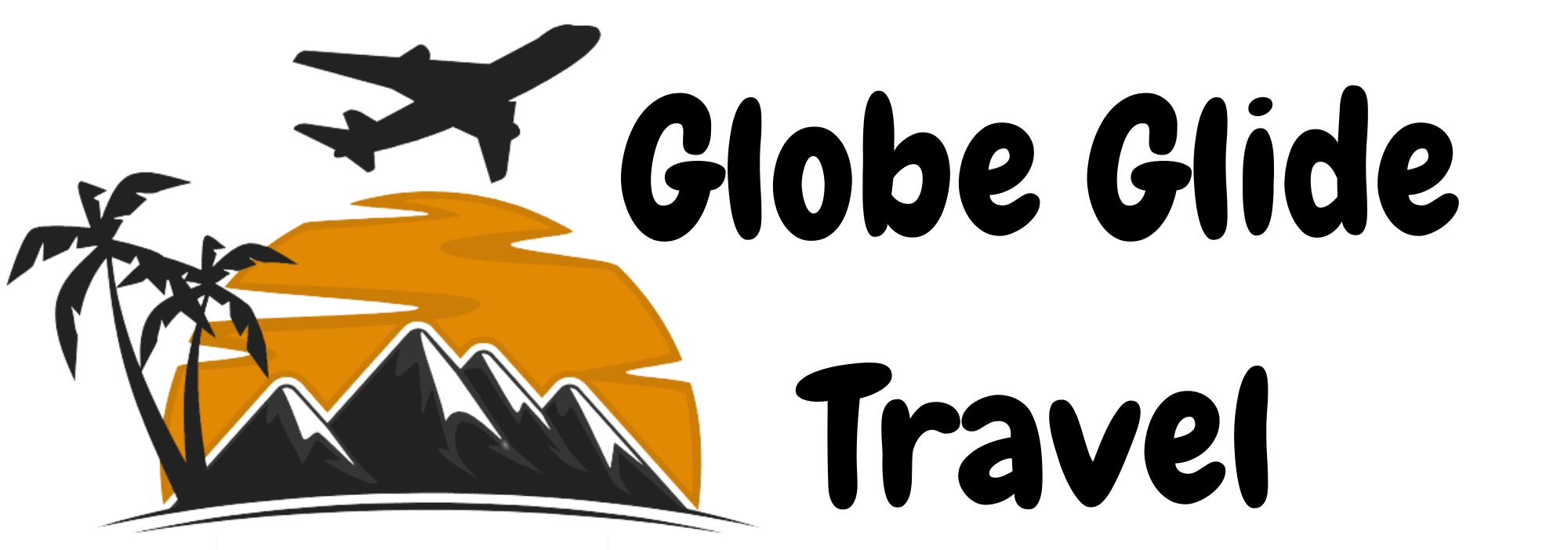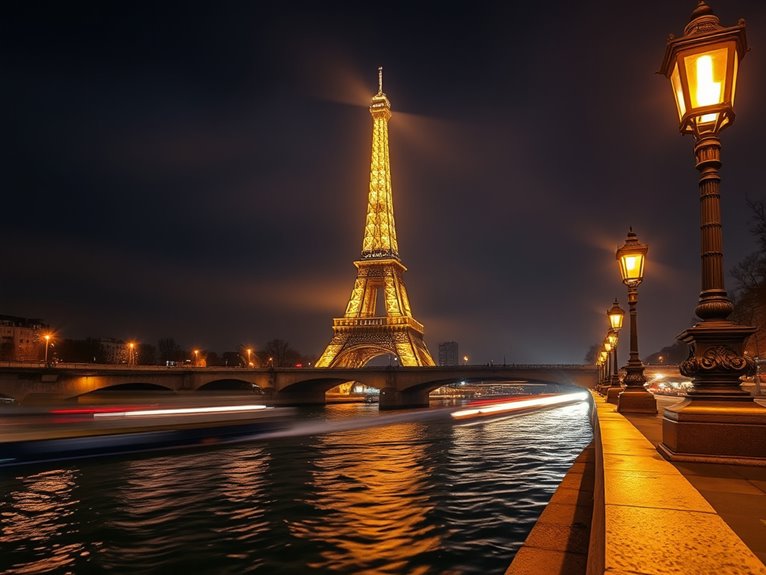
8 Best Spots for Night Photography in Paris
I've photographed Paris at night extensively, and these 8 spots will give you stunning shots: Trocadéro Platform for classic Eiffel Tower views, the ornate Pont Alexandre III, mystical Sacré-Cœur steps, Place de la Concorde's illuminated fountains, Notre-Dame Cathedral from Pont de la Tournelle, Arc de Triomphe's rooftop panoramas, Seine River banks at Les Invalides, and Rue de Rivoli's mesmerizing light trails. Each location offers unique perspectives, and knowing exactly when and where to set up makes all the difference!
Trocadéro Platform at Blue Hour
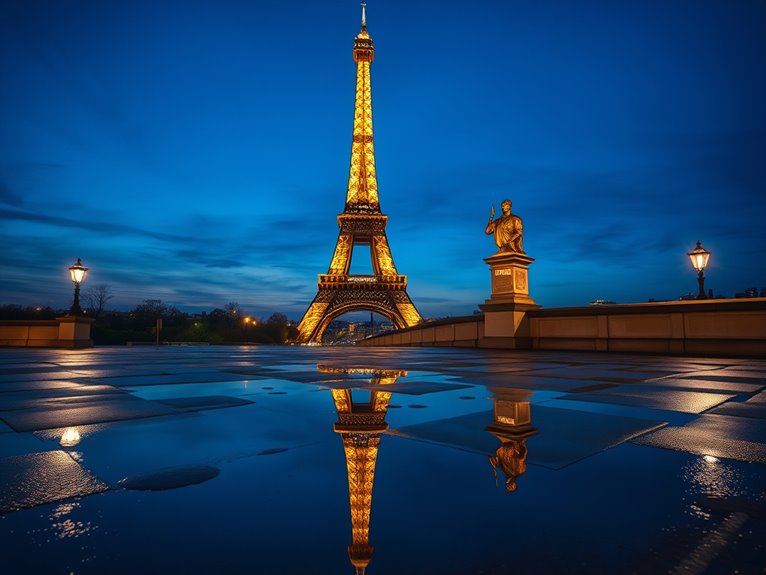
The Trocadéro Platform stands as Paris's premier vantage point for capturing the Eiffel Tower in all its illuminated glory. Positioned perfectly across the Seine, this elevated esplanade offers photographers an unobstructed view of France's most iconic monument, with the added drama of reflecting pools and architectural elements that frame the scene magnificently.
During blue hour, this location transforms into a photographer's paradise as the deepening twilight creates a perfect balance between natural and artificial light. The period when day fades to night provides an ethereal blue sky that contrasts beautifully with the warm glow of the Eiffel Tower's illumination, creating depth and atmosphere that's impossible to capture at any other time.
Quick Facts:
- Best Photography Time: 30-45 minutes after sunset
- Platform Access: Free, 24/7
- Closest Metro: Trocadéro (Lines 6 and 9)
- Tripod Use: Allowed
- Crowd Level: High during summer evenings
- Best Seasons: Spring and Fall for optimal lighting conditions
- Camera Requirements: Wide-angle lens recommended
The Trocadéro Platform is actually composed of several levels, with the main viewing area situated at the top of the Palais de Chaillot. The platform spans approximately 164 feet in width, providing multiple angles and compositions for photographers. The classical architecture of the platform itself, with its stone balustrades and statues, can serve as compelling foreground elements in your compositions.
Pro Tips:
Arrive at least 45 minutes before sunset to secure your preferred shooting position and set up your equipment. The Eiffel Tower's light show, which occurs every hour on the hour after nightfall, creates spectacular photo opportunities when combined with blue hour lighting. Consider using a neutral density filter to capture longer exposures that smooth out crowds and create silky reflections in the fountains.
Practical Advice:
Keep your equipment close and secure, as this area can get crowded with tourists. Consider purchasing a photography permit if you plan to use professional equipment or shoot commercially. The platform offers no shelter, so check weather conditions beforehand and bring appropriate protection for your gear. During peak tourist season (June-August), arrive even earlier to claim your spot, as photographers and tourists alike compete for the best viewing positions.
Pont Alexandre III After Dark
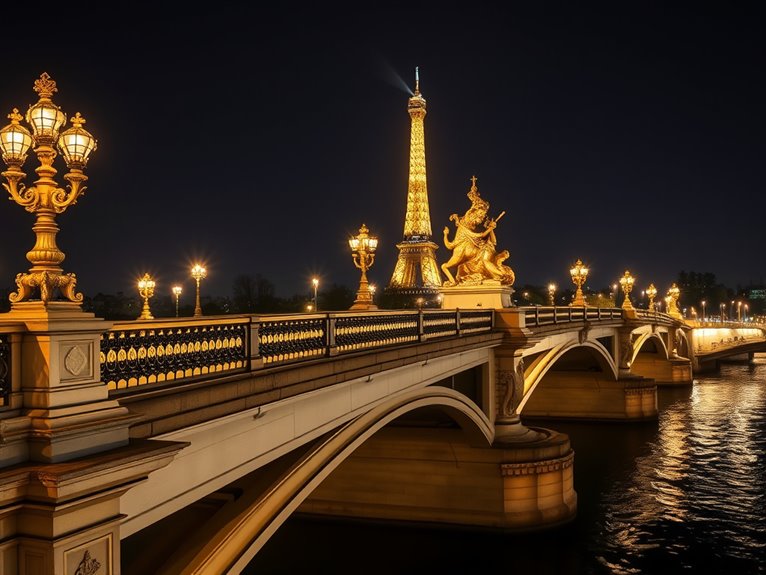
The most ornate bridge in Paris transforms into a magical spectacle as night falls, making it one of the city's premier locations for nocturnal photography. Its elaborate Art Nouveau lamps, gilded statues, and intricate ironwork create a symphony of light and shadow that captivates both amateur and professional photographers alike.
This Belle Époque masterpiece, spanning the Seine between the 7th and 8th arrondissements, offers unparalleled views of the Eiffel Tower and Grand Palais, while its own architectural elements provide countless opportunities for stunning nighttime compositions. The bridge's four-corner pillars, crowned with gilt bronze Pegasus statues, become dramatic silhouettes against the evening sky.
Quick Facts:
- Best Photography Hours: 9:00 PM – 11:00 PM (summer), 6:00 PM – 8:00 PM (winter)
- Lighting Conditions: Bridge lamps illuminate at sunset
- Tripod Usage: Permitted, but avoid peak pedestrian hours
- Camera Requirements: Low-light capable camera recommended
- Accessibility: 24/7, free admission
- Nearest Metro: Invalides or Champs-Élysées-Clemenceau
The bridge's central position offers multiple compelling shooting angles. The western view captures the Eiffel Tower's illumination, while the eastern perspective showcases the grand dome of Les Invalides. The ornate lampposts cast a warm, golden glow that reflects magnificently off the Seine's surface, creating opportunities for mirror-like water shots. Insider tip: The small stairways at either end of the bridge provide elevated vantage points rarely utilized by photographers.
Pro Tips:
The most dramatic photographs can be captured during the "blue hour" – approximately 20-30 minutes after sunset when the sky retains a deep blue color while the bridge's lights begin to shine. For the best results, arrive 30 minutes before sunset to scout locations and set up equipment. The bridge is less crowded on weekday evenings, making it easier to capture long exposures without pedestrian interference.
Practical Considerations:
Bring a sturdy tripod with rubber feet for stability on the bridge's surface, and consider using a remote shutter release to minimize camera shake. Weather protection for equipment is essential, as the Seine creates moisture conditions that can affect camera gear. Keep valuables secure and maintain awareness of surroundings, as the area, while generally safe, can be quiet during late hours.
Sacré-Cœur Steps at Midnight
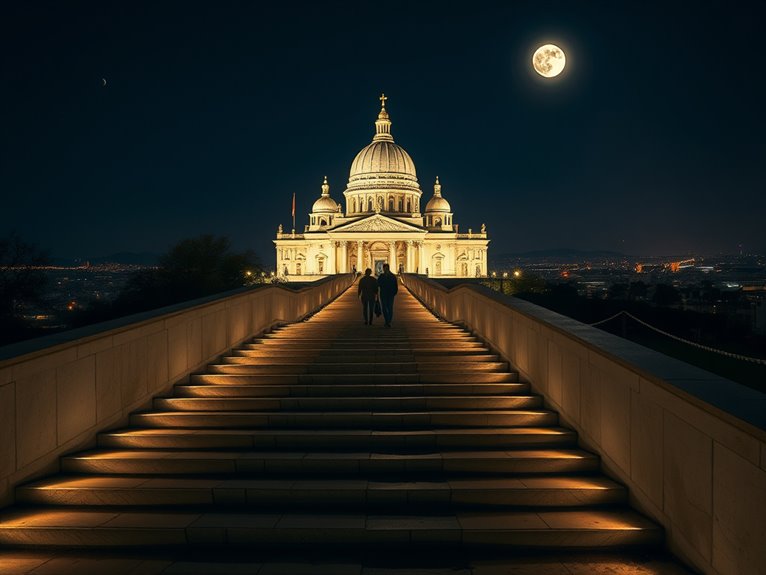
The iconic steps of the Sacré-Cœur Basilica transform into a magical photography spot when the clock strikes midnight, offering one of Paris's most enchanting nighttime views. From this elevated position in Montmartre, photographers can capture the City of Light living up to its name, with an endless sea of twinkling lights stretching toward the horizon.
As the tourists thin out and the street performers pack up for the night, the steps become an ideal location for both amateur and professional photographers seeking to capture the essence of nocturnal Paris. The combination of the illuminated basilica behind and the panoramic city views below creates opportunities for unique compositions that blend architectural and urban landscape photography.
Quick Facts:
- Best Photography Hours: 11 PM – 2 AM
- Access: Free, 24/7 to the steps
- Camera Equipment: Tripod essential
- Security: Regular police patrols
- Lighting Conditions: Mixed (basilica lights and city glow)
- Transportation: Metro Line 2 (Anvers) or 12 (Abbesses)
- Walking Distance: 5-minute uphill walk from nearest metro
- Best Weather: Clear nights, especially after rain
The steps of Sacré-Cœur provide photographers with a natural amphitheater-like setting, offering multiple levels and angles for composition. The stone steps themselves can serve as leading lines in photographs, drawing the viewer's eye from the foreground to the glittering city beyond. The basilica remains illuminated throughout the night, creating a dramatic backdrop that adds depth and context to any photograph.
Pro Tips:
Focus on capturing the interplay between the warm lighting of the basilica and the cooler city lights below. Consider using a neutral density filter to balance the extreme contrast between these light sources. For the best results, arrive around 11:30 PM to set up your equipment and scout the best shooting positions before the stroke of midnight, when the Eiffel Tower's sparkle show provides an additional element to your compositions.
Practical Advice:
While the area is generally safe, photographers should remain vigilant with their equipment and consider shooting with a companion. Use a remote shutter release or timer to minimize camera shake, and bring extra batteries as the cold night air can affect battery life. Consider bringing a small LED light for illuminating the immediate foreground if desired, and always check the weather forecast before planning your shoot, as fog or rain can dramatically alter the viewing conditions from this elevated position.
Place De La Concorde's Fountains
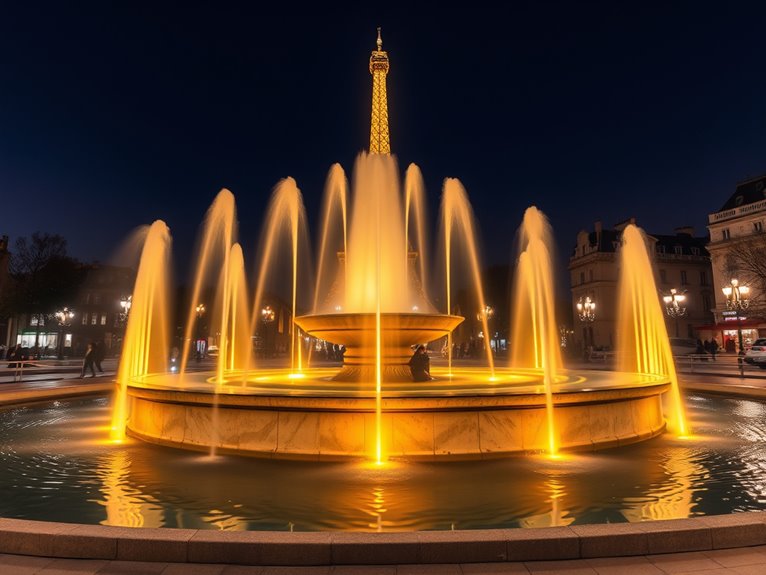
The majestic fountains of Place de la Concorde transform into ethereal sculptures after sunset, when their illuminated waters dance against the backdrop of Paris's golden lights. These historic fountains, dating back to the reign of Louis-Philippe, create mesmerizing reflections and light plays that make them one of Paris's most enchanting subjects for night photography.
Two magnificent maritime-themed fountains dominate the octagonal plaza, representing France's maritime heritage through elaborate sculptures of river deities and sea creatures. The interplay between water, light, and shadow, combined with the square's strategic position between the Champs-Élysées and the Tuileries Garden, offers photographers unique opportunities to capture both classical architecture and modern urban nightscapes.
Quick Facts:
- Best Photography Hours: 9 PM – 11 PM (summer), 6 PM – 9 PM (winter)
- Fountain Operation: Daily until midnight
- Lighting Schedule: Dusk until 1 AM
- Tripod Usage: Allowed without permit
- Crowd Levels: Moderate to high during summer evenings
- Metro Access: Lines 1, 8, 12 (Concorde station)
The Fontaine des Fleuves (Fountain of Rivers) faces the Champs-Élysées and offers the most dramatic compositions, with the Arc de Triomphe visible in the background. This fountain features allegorical figures representing France's major rivers, creating striking silhouettes against the illuminated water jets. The best vantage point is from the northwest corner of the plaza, where photographers can capture both the fountain and the avenue's twinkling lights.
The Fontaine des Mers (Fountain of Seas) provides equally compelling photo opportunities with its maritime theme and proximity to the Tuileries Garden. Less photographed than its counterpart, this fountain often offers clearer shots without crowds. A little-known secret: the fountain's western side catches beautiful golden reflections from nearby street lamps, creating a warm glow that contrasts beautifully with the cool LED illumination.
Pro Tips:
The ideal conditions for fountain photography occur 30 minutes after sunset during the "blue hour," when the sky retains some natural light while the artificial illumination reaches full intensity. Use a neutral density filter to achieve longer exposures, creating silk-like effects with the flowing water. Position yourself at different heights – ground level shots can capture stunning reflections, while elevated positions from nearby café terraces offer unique perspectives of the entire plaza.
Practical Advice:
Bring a sturdy tripod and remote shutter release for sharp long exposures. Weather protection for your equipment is essential, as water spray can travel considerable distances on windy evenings. Consider visiting during weekday evenings to avoid weekend crowds, and arrive early to scout ideal positions. The plaza's generous space allows for various compositional options, but be mindful of other photographers and tourists sharing the space.
Notre-Dame Cathedral From Pont De La Tournelle
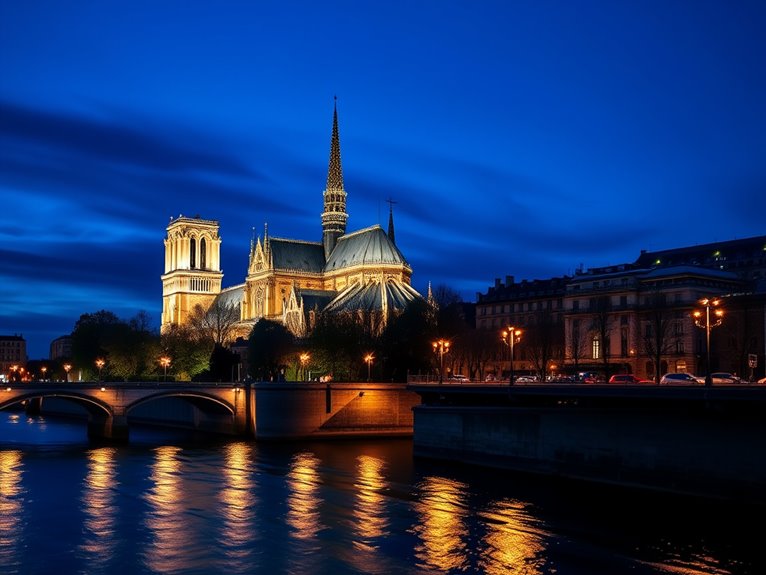
Standing on the historic Pont de la Tournelle bridge offers photographers one of the most breathtaking views of Notre-Dame Cathedral's eastern facade, particularly during nighttime hours. The iconic cathedral, even during its restoration following the 2019 fire, creates a magnificent silhouette against the Parisian night sky, with its flying buttresses and spire beautifully illuminated.
This vantage point provides an unparalleled composition opportunity, allowing photographers to capture both the cathedral's architectural grandeur and its reflection in the Seine River's waters. The bridge's location on the Left Bank enables artists to frame Notre-Dame with surrounding historic buildings and the ambient lights of the city, creating depth and context in nighttime shots.
Quick Facts:
- Best shooting times: Blue hour (just after sunset) to 11 PM when lights illuminate the cathedral
- No entry fee for bridge access
- Camera equipment recommended: Tripod, wide-angle lens, neutral density filters
- Distance from nearest Metro: 5-minute walk from Cardinal Lemoine (Line 10)
- Ideal shooting seasons: Spring and Fall for clearest skies
- Security presence: Regular police patrols guarantee safety during night hours
The Pont de la Tournelle location stands out for its unique positioning at a slight angle to Notre-Dame, offering photographers the ability to capture the cathedral's eastern end and its architectural details in perfect proportion. The bridge itself, built in 1928, features elegant lampposts that can be incorporated into foreground elements, adding depth to nighttime compositions. The spot is easily accessible via the Left Bank at 47 Quai de la Tournelle, and photographers can set up their equipment along the bridge's pedestrian walkway.
Pro Tips:
For the most dramatic shots, arrive 30 minutes before sunset to secure the best shooting position and capture the shift from daylight to artificial illumination. Consider using a remote shutter release and bracketing your exposures to capture both the bright cathedral lights and the darker surrounding elements. On weekends, shooting before 9 PM helps avoid crowds of other photographers and tourists who often gather later in the evening.
Practical Considerations:
Weather protection for camera equipment is essential, as wind and moisture from the Seine can be significant factors. Bring a lens cloth to combat moisture, and consider using sandbags to stabilize your tripod against bridge vibrations from passing vehicles. Parking is limited in the area, so using public transportation is strongly recommended. Local cafes near the bridge provide convenient refuge for warming up during cold nights or waiting out brief rain showers.
Arc De Triomphe Rooftop View
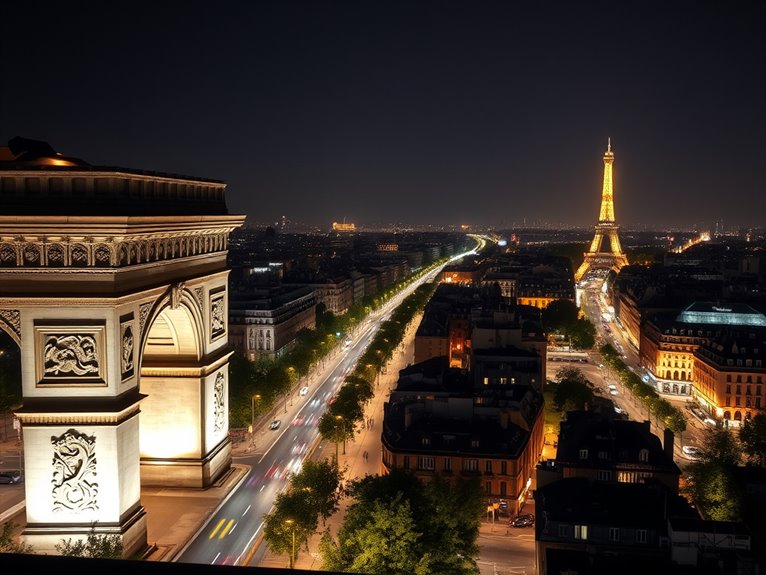
Perched atop the western end of the Champs-Élysées, the Arc de Triomphe's observation deck offers one of Paris's most spectacular vantage points for night photography. From this elevated position, photographers can capture the radiant streams of traffic circling the monument, the illuminated sweep of the Champs-Élysées, and the glittering Eiffel Tower in the distance.
The 360-degree panoramic view provides unique opportunities to photograph Paris's iconic nightscape, with twelve radiating avenues creating stunning light trails in long-exposure shots. The elevation of 50 meters offers an excellent perspective for capturing both intimate street scenes below and broader cityscapes that showcase Paris's architectural grandeur bathed in evening light.
Quick Facts:
- Opening Hours: 10:00 AM – 10:30 PM (April to September), 10:00 AM – 9:30 PM (October to March)
- Cost: €13 for adults, free with Paris Museum Pass
- Best Photography Times: Blue hour (just after sunset) and 9:00 PM – 10:00 PM
- Equipment Allowed: Tripods permitted after 7:00 PM
- Access: 284 steps or elevator (for those with limited mobility)
- Photography Permits: Not required for personal use
The Observation Deck Experience:
The rooftop area features a spacious viewing platform with protective barriers that don't obstruct camera views. The deck's design includes strategic gaps perfect for positioning cameras without interference. An indoor exhibition area provides shelter during inclement weather and offers historical context through multimedia displays. Little-known fact: The northwest corner of the platform offers an unobstructed view of La Défense, Paris's modern business district, creating a striking contrast between historical and contemporary architecture.
Pro Tips:
To capture the best night photographs, arrive 30 minutes before sunset to secure a prime position and witness the transformation of the city from day to night. Use the corner positions for the clearest shots of traffic light trails, and consider bringing a remote shutter release for sharp long exposures. The security staff typically allows photographers to remain slightly beyond official closing time if they're in the middle of capturing important shots – but always ask politely and be prepared to wrap up quickly.
Practical Considerations:
Reserve tickets online to avoid queues, and access the monument via the underground passage (located at the Champs-Élysées-Clemenceau or Charles de Gaulle-Étoile metro stations) rather than attempting to cross the roundabout. Weather conditions greatly impact photo quality, so check the forecast and avoid foggy or rainy evenings. Consider bringing a lens cloth to combat evening humidity, and wear comfortable shoes as you'll likely be standing for extended periods while waiting for perfect shot opportunities.
Seine River Banks at Les Invalides
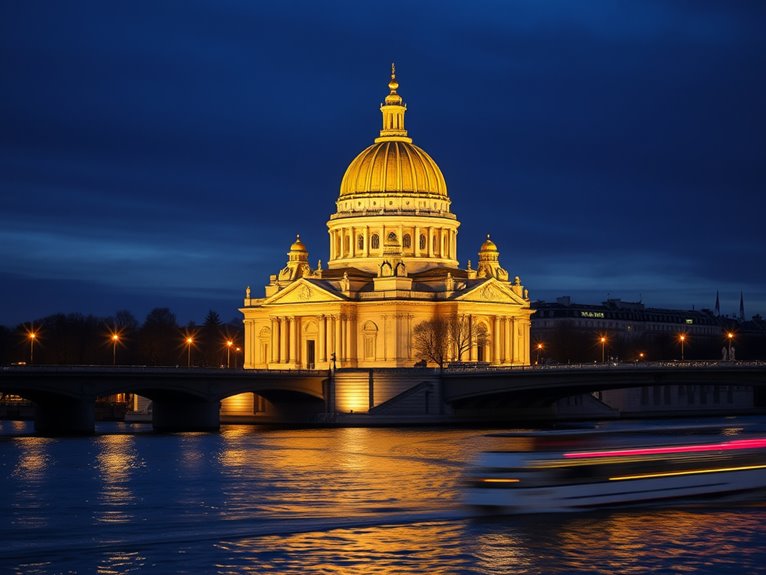
The Seine River banks near Les Invalides offer one of Paris's most alluring nocturnal photography locations, where the golden dome of Les Invalides creates a mesmerizing reflection on the river's surface. This stretch of the Seine combines historical architecture, strategic lighting, and the natural movement of water to create stunning nighttime compositions that capture the essence of romantic Paris.
Photographers are drawn to this location for its unique combination of elements: the architectural grandeur of Les Invalides, the rhythmic patterns of the pont Alexandre III bridge lights, and the gentle ripples of the Seine that transform ordinary reflections into abstract light paintings. The area provides multiple vantage points and perspectives, making it possible to capture diverse shots from a single location.
Quick Facts:
- Best shooting hours: 9 PM – 11 PM (summer), 6 PM – 8 PM (winter)
- Tripod allowed: Yes (no permit required)
- Nearest Metro: Invalides (Lines 8, 13)
- Safety rating: High, well-lit and patrolled area
- Best conditions: Clear nights or after light rain
- Peak times to avoid: Sunset boat tour hours (7 PM – 8:30 PM)
The Left Bank Perspective
Located between Pont Alexandre III and Pont des Invalides, the left bank offers an unobstructed view of Les Invalides' dome and its reflection. This spot is particularly effective for long-exposure shots that capture the movement of river traffic against the static grandeur of the illuminated building. The nearby benches and wide walkways provide stable platforms for tripod setup.
The Right Bank View
The opposite bank presents a broader panoramic perspective, incorporating both Les Invalides and the ornate Pont Alexandre III in a single frame. This location is less crowded than the left bank and offers unique elevated positions from the port de la Conférence. The stone walls along the upper level serve as natural leading lines in compositions.
Bridge Perspectives
Both Pont Alexandre III and Pont des Invalides offer distinctive vantage points for capturing the golden dome's reflection. The ornate lampposts on Pont Alexandre III can serve as compelling foreground elements, while the simpler Pont des Invalides provides cleaner compositions focusing on the building's reflection.
Pro Tips:
The prime time for photography occurs during "blue hour" – approximately 20-30 minutes after sunset when the sky retains a deep blue color but the buildings are fully illuminated. For the most dramatic shots, position yourself on the left bank during boat passages, as their wake creates dynamic patterns in the water reflections. Consider using a neutral density filter to achieve longer exposures even during the early evening hours when there's still ambient light.
Practical Advice:
Bring a sturdy tripod with rubber feet for stability on the stone surfaces, and consider a remote shutter release to minimize camera shake during long exposures. The area can get windy, so a weight hook on your tripod is recommended. While the area is generally safe, keep your equipment bag close and consider bringing a photography companion during later hours. Public restrooms are available near the Invalides metro station, and several cafes along Rue Saint-Dominique remain open late for warm refuge during winter shoots.
Rue De Rivoli's Light Trails
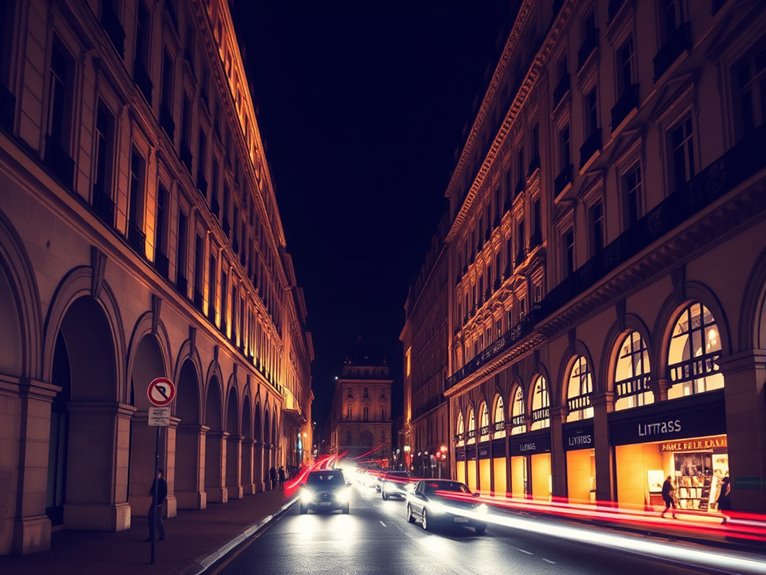
The historic Rue de Rivoli transforms into a photographer's paradise after sunset, when the endless stream of vehicles creates mesmerizing light trails against the backdrop of elegant 19th-century arcades. This iconic Parisian street, stretching 3 kilometers from Place de la Concorde to the Marais district, offers unique opportunities for capturing dynamic urban photography that embodies the city's perpetual motion.
Photographing light trails along Rue de Rivoli combines classical architecture with modern energy, as the steady flow of traffic paints ribbons of red and white light across your frame. The street's distinctive covered walkways, uniform building façades, and strategic position near major landmarks make it an exemplary location for both beginning and experienced night photographers to practice long-exposure techniques.
Quick Facts:
- Best shooting times: 6 PM – 11 PM (winter), 9 PM – 12 AM (summer)
- Equipment needed: Tripod, camera with manual settings, remote shutter
- Best viewing spots: Near Louvre entrance, Châtelet intersection
- Weather conditions: Clear nights preferred, light rain can create reflective effects
- Security: Generally safe, but maintain awareness of surroundings
- Permits: Not required for personal photography
Prime Shooting Locations:
The Louvre-Rivoli Intersection offers the perfect vantage point for capturing light trails with the illuminated Louvre facade in the background. Position yourself near the Metro entrance for elevated shots that include both approaching and departing traffic. Insider tip: The security guards at the Louvre are usually amenable to photographers setting up tripods on the raised platform near the museum entrance, providing an excellent elevated perspective.
The Châtelet Crossroads presents opportunities for capturing multiple light trail patterns as vehicles navigate the complex intersection. The historic buildings and shop windows provide additional lighting elements that add depth to nighttime compositions. Unique feature: The Art Nouveau Metro entrance creates an interesting foreground element when shooting from the north side of the street.
Pro Tips:
The ideal camera settings for light trails on Rue de Rivoli typically include an aperture of f/8-f/11, ISO 100-400, and shutter speeds between 5-30 seconds depending on traffic flow. Stack multiple exposures in post-processing to create denser light trails during periods of lighter traffic. Consider using a neutral density filter during blue hour when ambient light is still relatively strong but traffic flow is increasing.
Practical Advice:
Arrive early to scout locations and secure your shooting spot, as the most strategic positions can become crowded with other photographers, especially during peak tourist season. Bring extra batteries and memory cards, and consider weather protection for your equipment as evening moisture can accumulate on lens surfaces. Working in pairs is recommended for safety and to help watch equipment while adjusting camera positions or changing lenses.
